This is Part 4 in the Road to Vegas series. To read the other installments, click here.
Perched in a wide valley at the south end of Walker Lake is the town of Hawthorne. If you’re making the drive from Carson City, and following along with this web series, Hawthorne will be the first town you run into that’s actually located along Hwy 95 itself. Walker Lake is also the last glimpse you’ll have of water for a very long time, so enjoy it while you can.
The origins of Hawthorne lie not in mining or agriculture, like so many of Nevada’s other towns, but in the railroad. In 1880, the Carson and Colorado Railroad was being built from Mound House down to the Owens Valley in California. The Carson and Colorado was meant to replace the wagon roads that criss-crossed the area and make it easier to haul ore out of all the small mining towns that had been springing up along the Nevada-California border. Several of these wagon roads intersected at the south end of Walker Lake, so it was decided this would be a good place to build a division and distribution point for the railroad. Legend has it that the work crews building the railroad turned their pack mules loose to fend for themselves during the winter of 1880-81, and when they returned the next spring they found that the herd had settled itself into the most sheltered part of the valley to survive the cold winter. If it was good enough for the mules it was good enough for the humans, so the townsite of Hawthorne was laid out on the same spot.
However the site was picked, the town quickly took hold. Hawthorne grabbed the title of Esmeralda county seat in 1883, but later lost it in 1907 to the boom town of Goldfield. Four years later a new county, Mineral County, was carved out of the northern half of Esmeralda County, and Hawthorne regained its county seat status and reopened its court house.
Through these years, though, the population of the town never rose above a few hundred. The Carson and Colorado Railroad was sold to Southern Pacific in 1900, and the rail line was rerouted away from the town. The town survived by being a supply center for all of the small mining operations in the area, but Hawthorne was always in danger of shriveling up and blowing off the map.
Until the 1920s, that is. Because in 1926 a disaster happened on the opposite side of the country that would forever alter the destiny of the town. That was the year that the U.S. Naval Ammunition Depot in Lake Denmark, New Jersey exploded, killing 21 people and sending raining shrapnel into the surrounding communities. After this disaster, the Navy decided that maybe the middle of a heavily populated area wasn’t the best place to stockpile all of their ammunition, so they set off in search of a more desolate location in the vast expanses of the West. The place they finally chose was tiny little Hawthorne, and in 1930 the first shipment of high explosives arrived at the new Hawthorne Naval Ammunition Depot. After that Hawthorne became a military town, and its entire reason for existence shifted to supporting the Depot. At the height of World War II over 5,000 people were employed at the Depot, supplying munitions for the entire American war effort. The population of the town itself topped out at 13,000.
The years since World War II have seen a decline in the importance of the Hawthorne Depot, but even after all these years it is still in operation. In 1977 control of the Depot was transferred to the army, and nowadays it’s mostly civilian personnel, working for the Day & Zimmermann Hawthorne Corporation, that keep watch over the ammunition buried in the desert. The bunkers dotting the landscape surrounding Hawthorne are just one of the oddities you’ll run across on The Road To Vegas. Now, on to the pictures!
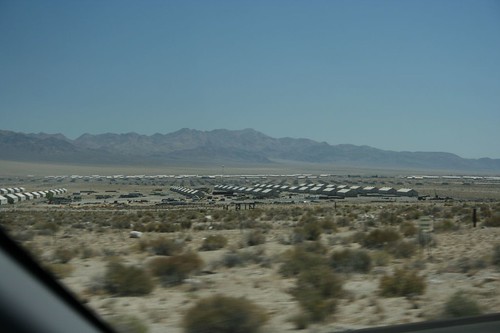
This is what’s most visible as you approach Hawthorne, long rows of military buildings filling up the valley.
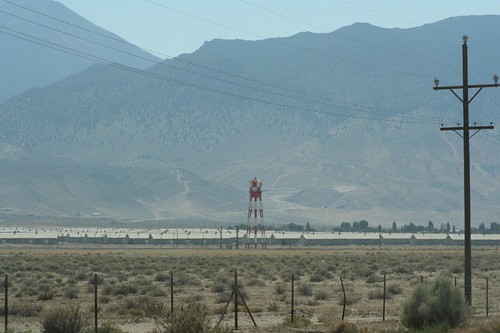
They stretch off into the distance, punctuated by an occasional tree or water tower.

The actual ammunition bunkers stretch way up the alluvial plains, clustered in groups and connected by dirt roads.
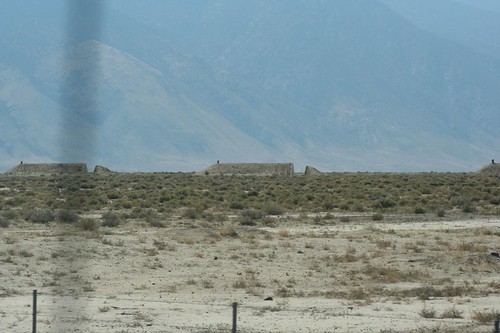
The bunkers are all the same. Rectangular mounds of dirt, with a notch cut through them and a doorway giving access to the storage areas within.
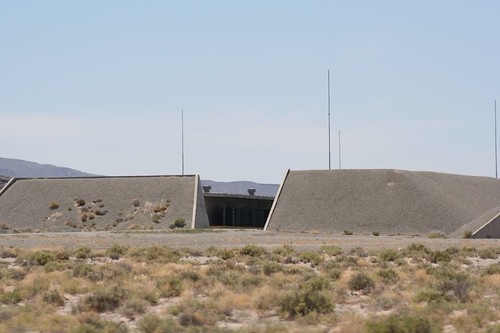
There are a few of these larger facilities scattered throughout the valley as well. The notches are cut to allow train tracks to enter the bunker.
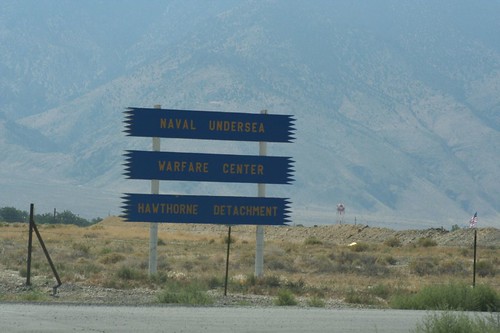
One of the oddest sights on the whole Road to Vegas is this sign, advertising an “Undersea Warfare Center” on an access road. A submarine base in the Hawthorne desert?
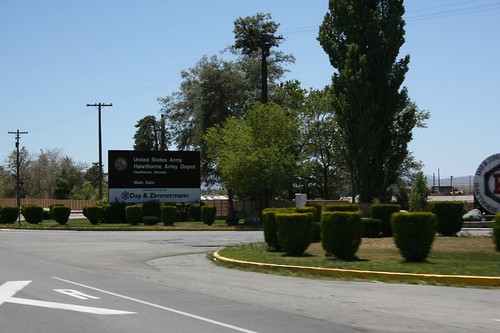
This is the main gate to the Depot, a collection of offices and administration buildings that is actually located on the other side of town from the bunkers. Apparently the town golf course is also through these gates.
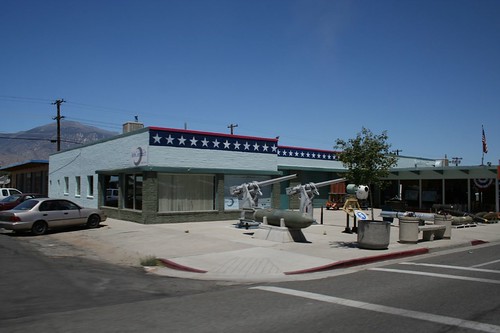
The Hawthorne Ordnance Museum, located on Hawthorne’s main street, houses several large guns and a collection of ammunition dating back to the early 20th century.
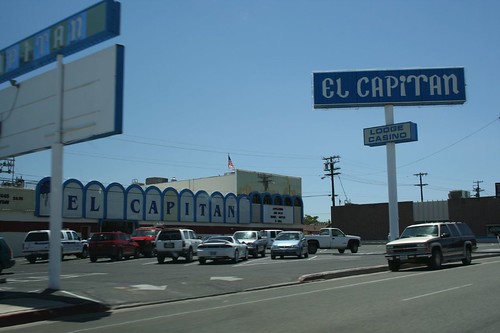
The El Capitan casino is Hawthorne’s second-largest employer, located right at a bend in the highway. This gaudy blue facade doesn’t look to have been updated in several decades, and I imagine the interior hasn’t either.
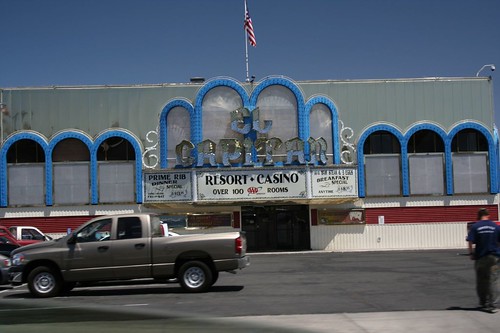
But the El Capitan still brings in the customers because of its size and its prominence. Only in Tonopah will you find another casino this size along the Road to Vegas, so if travelers are planning to stop and do some gambling along the way, the odds are good they’re going to do it here. Add a bar, restaurant, and over 100 motel rooms, and the El Capitan becomes an oasis in the desert.
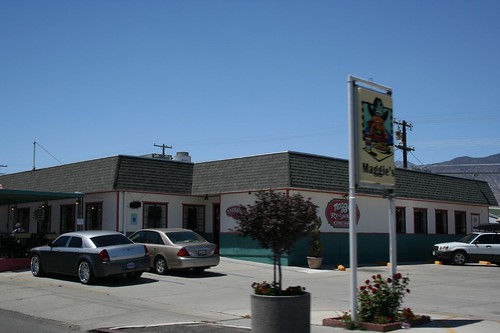
Not that the El Capitan doesn’t have competition. It’s not the only food or lodging in town, after all. The sign at Maggie’s promises good burgers, good fries, and ten-gallon hats for all.
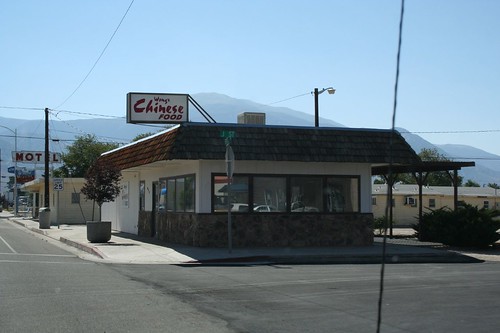
Wong’s Chinese Food is located in this little hut on J Street.
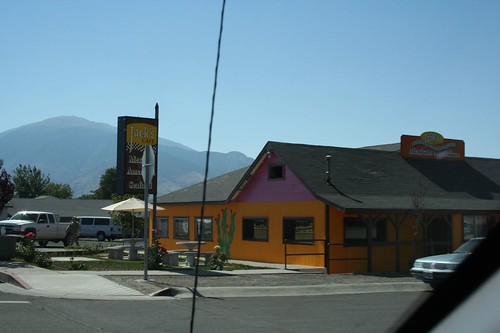
And Jack’s Cafe is sure to get your attention with its lavender and orange color scheme. Whether the “Mexican American Seafood” that is served at Jack’s lives up to the promises of its decor is another matter.
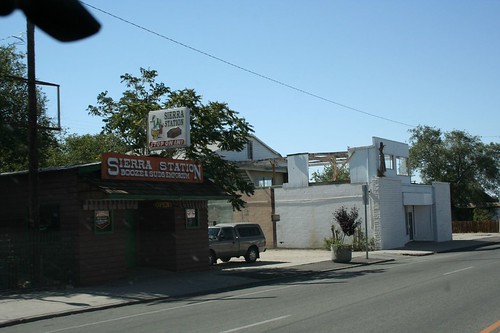
The Sierra Station proclaims itself to be a booze and suds emporium, and despite its gloomy exterior it exhorts the weary traveler to “Stop On In!”
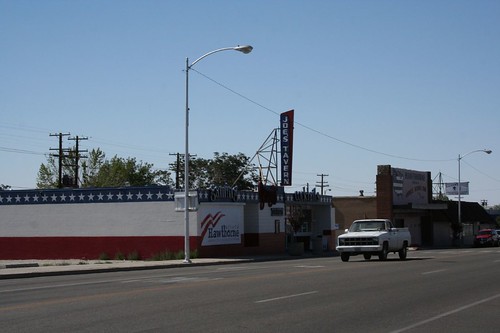
Joe’s Tavern is painted a very patriotic red white and blue, with a strip of stars along its roofline.
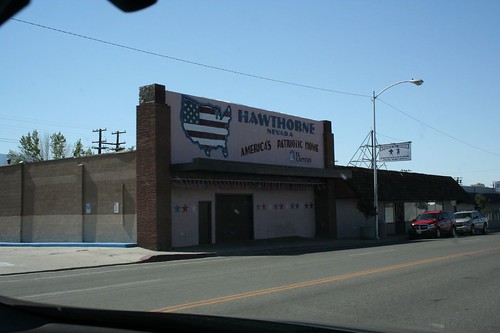
Next door to Joe’s Tavern, this building proclaims Hawthorne to be “America’s Patriotic Home”.
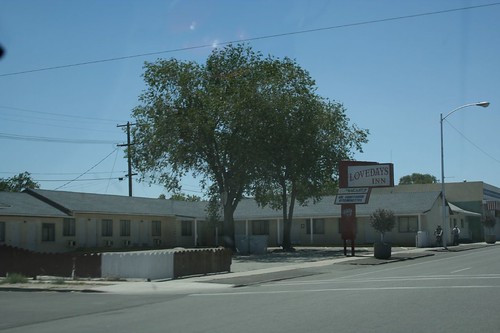
There is no shortage of lodging in Hawthorne either. The main drag is littered with a series of small postwar motels, each of them hoping you choose not to stay at the El Capitan but spend a night with them instead. The Lovedays Inn offers you kitchenettes and an empty parking lot.
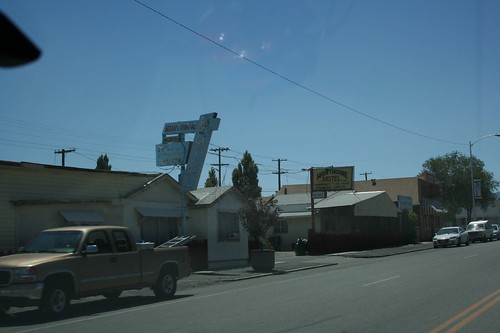
The Hawthorne Motel has two signs. When the blue one became unreadable, they just put up the yellow one.

The Anchor Motel is not only under new management, it’s also within convenient walking distance of the Hawthorne Ordnance Museum.
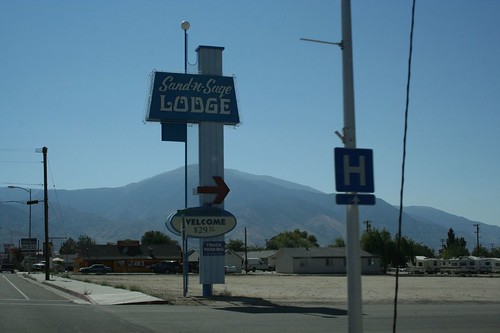
The Sand and Sage Lodge is not even located on the main highway, but they have put up this sign so everyone knows they’re there.
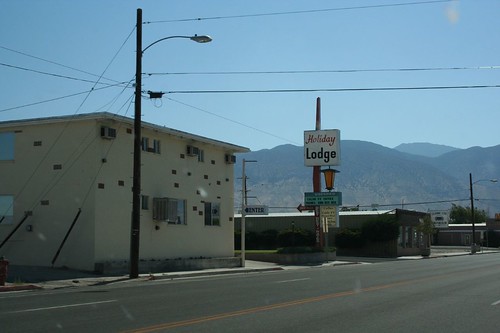
The Holiday Lodge appears to actually be two stories high, as well as openly advertising such modern amenities as color TVs and telephones.
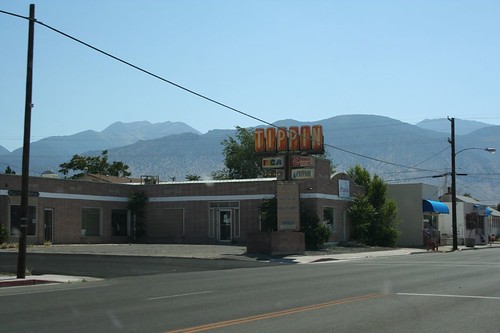
The Tippin Appliances building is wholly uninteresting, like it’s actively designed to make you look in the opposite direction. But the sign is what’s interesting here, with 40-year-old logos for RCA, GE, and Propane.
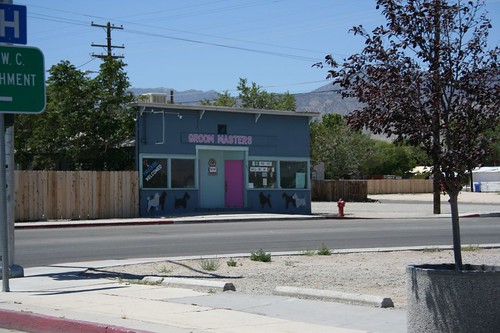
Groom Masters grooming salon is located right at the heart of town. What’s funniest about this building is the sign in the window that says, “Truckers Welcomed.” I’d like to see the demographics on how many truck drivers stop by to get their poodles groomed.

This strip mall lies in the shadow of the El Capitan. Here you can find the Hawthorne Mini Mart, a smoke shop, Diego’s Mexican Food, Wee Hawk Pawn, and the Happy Buddha Thai and Chinese Cuisine.
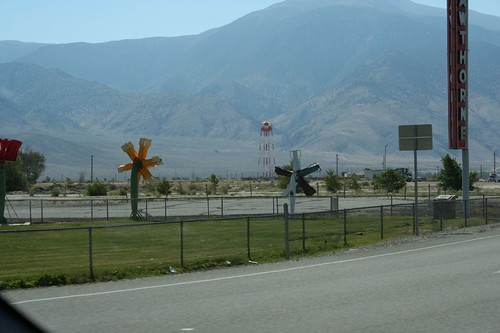
At the edge of town, across the street from the McDonald’s (which probably does more business than every other restaurant I mentioned here combined), you find this art installation. Bomb casings turned into windmills, which actually rotate with the breeze.
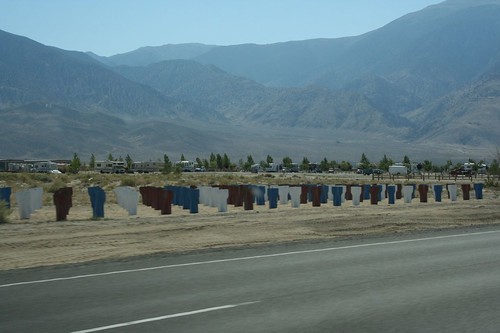
And just down the road is more military-style art. Hundreds of bomb casings, stuck ass-up in the sand next to the highway. This installation also marks the townsite of Babbitt, a community that was built during World War II to house civilian employees of the Depot. Babbitt was comprised of an orderly grid of streets, named for U.S. aircraft carriers, and lined with identical duplex units. After the Korean War the need declined for the extra housing Babbitt provided, and over the next few decades the community was slowly dismantled, street by street. The last residents moved out in 1987, and now there is nothing left but a series of ghost streets in the desert, dotted by concrete foundations.
More reading on Hawthorne can be found at nevadaweb.com and ghosttowns.com, and the Hawthorne Live blog, updated frequently by Nevada Mike.


Great stories and pictures. Enjoyed it all even on my turtle slow computer.
WHAT ABOUT DIESEL FUEL?
What about mineral county memorial rose garden and the veteran’s memorial park?